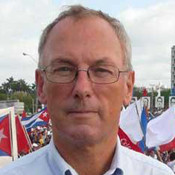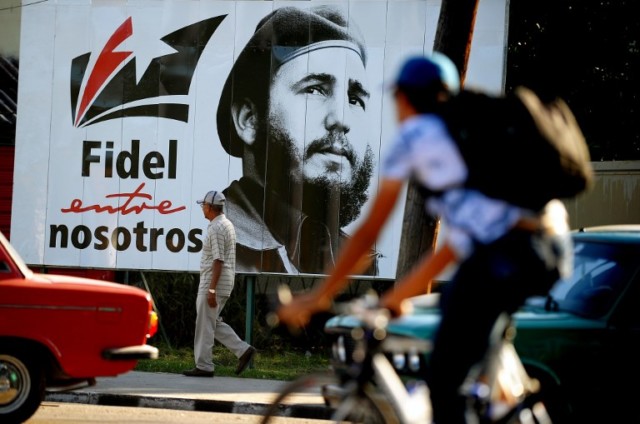Thousands of Cubans gathered at the University of Havana on Saturday evening to pay tribute and mark the first anniversary of the death of former leader Fidel Castro. He died, age 90, on November 25, 2016.
CGTN’s Michael Voss attended the rally and files this Reporter’s Notebook. 
It was more of a festive occasion, celebrating the life of Cuba’s former leader Fidel Castro, rather than mourning his demise. On Saturday night, hundreds of students and other Cubans packed the giant steps leading up to the University of Havana.
Castro was a law student here at the school and it was here he first became involved in radical politics. He became one of the leading political giants of the 20th century, leading the Cuban revolution and ruling the island for more than half 50 years.
The rally marks the start of a week-long series of events which will culminate on Sunday December 4th with a procession through Cuba’s second city, Santiago, to the Santa Ifigenia cemetery where Castro was laid to rest.
Bars closed for the day and no alcohol is available in the shops as Cubans mark the day their former leader died.
Among Fidel Castro’s dying wishes were that no statues be built of him, nor roads, buildings or parks named after him.
Cuba has honored that request, although this week pictures of Fidel have appeared in shop windows with many schools and workplaces laying floral tributes beneath his portrait.
The University of Havana is where, as a law student, Fidel Castro first became involved in radical politics. It is also the first place that I saw Fidel give a speech in public.
I arrived in Cuba in 2007, the year after he had stepped down due to ill health, passing the leadership onto his younger brother, Raul Castro. In 2010, having partially recovered, Fidel Castro donned his trademark olive military fatigues and gave an open air public address.
I joined thousands of students and other supporters that day as they filled the steps leading up to the University of Havana to catch a rare glimpse of their former leader.
Similar huge crowds turned out this Saturday evening to pay tribute to the man referred to today as the ‘Historic Leader of the Cuban Revolution.’
Fidel Castro ruled Cuba for more than half a century, the last great leader of the Cold War era, an icon of the left and a constant thorn in the side of his giant neighbor, the United States.
Today Cuba remains the only Communist-run state in the Western Hemisphere.
Fidel Castro had been out of power for more than a decade but remained an influential figure. There was speculation, especially abroad, about whether his death would lead to a more rapid pace of change.
In many ways the reverse has happened. The growth of the private sector appears to have stalled with new restrictions on opening restaurants and lodgings. There had been talk of electoral reform, but that too has stalled.
The biggest changes in Cuba over the past year have come from external factors.
Just weeks before Castro’s death, Donald Trump was elected U.S. President and instead of engagement he has added new sanctions on trade and travel.
The crisis in Venezuela has also taken its toll with a significant reduction in subsidized oil supplies.
Then came Hurricane Irma, which caused extensive damage, further stretching an already struggling economy.
As well as paying tribute to the past, many Cubans are also looking to the future and the start of a political cycle which should result in his brother Raul Castro giving up the presidency.
Municipal elections are taking place on Sunday, the first of three stages that will lead to a new National Assembly of People’s Power, which will meet for the first time in February 2018.
Raul Castro has already announced that he intends to step down. Fifty-seven-year-old First Vice President Miguel-Diaz Canel is expected to succeed him although it’s not guaranteed.
It could prove a gradual transition, though, as 86-year-old Raul Castro will continue as head of the Cuban Communist Party.
 CGTN America
CGTN America
 A man walks past a poster of late Cuban leader Fidel Castro, in Havana on November 24, 2017.
(AFP PHOTO / YAMIL LAGE)
A man walks past a poster of late Cuban leader Fidel Castro, in Havana on November 24, 2017.
(AFP PHOTO / YAMIL LAGE)
